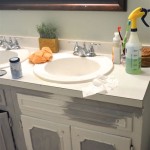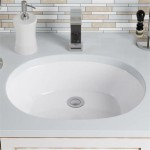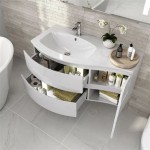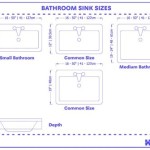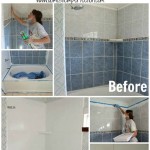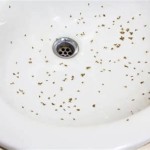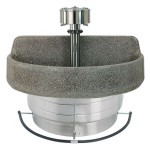Bathroom Single Sink Vanity Ideas: Optimizing Space and Style
The single sink vanity remains a staple in bathroom design, offering a practical and aesthetically versatile solution for various spaces. Its compact nature makes it ideal for smaller bathrooms, powder rooms, and en-suites where maximizing floor space is paramount. However, the single sink vanity is not limited to small spaces; it can also serve as a strategic design element in larger bathrooms, contributing to a more streamlined and efficient layout. The key to successful single sink vanity integration lies in thoughtful planning and the selection of a unit that balances functionality, style, and storage capacity.
This article explores a range of single sink vanity ideas, focusing on design considerations, material options, storage solutions, and installation tips. The aim is to provide a comprehensive guide for homeowners and designers seeking to enhance their bathrooms with a single sink vanity that meets their specific needs and aesthetic preferences.
Understanding Your Bathroom Space and Needs
Before embarking on the selection process, it is crucial to thoroughly assess the existing bathroom space. This assessment should encompass several factors, including the overall dimensions of the bathroom, the location of existing plumbing connections, the desired style and theme, and the storage requirements of the occupants. Measuring the available space is paramount to ensuring the chosen vanity fits comfortably without obstructing movement or overcrowding the area. Consider the distance between the vanity and other fixtures, such as the toilet and shower, to maintain adequate clearances.
The location of existing plumbing will significantly influence the placement and type of vanity that can be installed. Moving plumbing can be costly and time-consuming, so it is often more practical to work within the constraints of the existing layout. If relocating plumbing is unavoidable, consult with a qualified plumber to determine the feasibility and cost implications.
Identifying the desired style and theme is essential for selecting a vanity that complements the overall bathroom design. Whether the aesthetic is modern, traditional, rustic, or minimalist, the vanity should seamlessly integrate with the existing décor. Consider the color palette, materials, and textures used throughout the bathroom to ensure a cohesive and harmonious look.
Storage needs are often overlooked but are a critical aspect of vanity selection. Evaluate the types and quantities of items that need to be stored in the vanity, such as toiletries, towels, cleaning supplies, and personal care products. This assessment will help determine the required storage capacity and the optimal configuration of drawers, shelves, and cabinets.
Exploring Different Vanity Styles and Designs
Single sink vanities are available in a wide array of styles and designs, each offering unique aesthetic and functional characteristics. Understanding the different types of vanities is essential for making an informed decision that aligns with personal preferences and bathroom dimensions.
Freestanding Vanities: These vanities are self-supporting units that stand on the floor, offering a classic and versatile option for various bathroom styles. Freestanding vanities are typically easy to install and provide ample storage space. They are available in a range of sizes, shapes, and materials, making them a popular choice for both small and large bathrooms.
Wall-Mounted Vanities: Also known as floating vanities, these units are attached directly to the wall, creating a sense of openness and spaciousness in the bathroom. Wall-mounted vanities are particularly well-suited for smaller bathrooms where maximizing floor space is a priority. They also facilitate easier cleaning underneath the vanity.
Corner Vanities: Designed to fit snugly into the corner of a bathroom, these vanities are an excellent space-saving solution for compact bathrooms and powder rooms. Corner vanities typically feature a triangular or curved design, allowing them to efficiently utilize otherwise underutilized space.
Console Vanities: Combining elements of freestanding and wall-mounted vanities, console vanities feature a countertop supported by decorative legs or a metal frame. These vanities offer a stylish and elegant look, often incorporating open shelving for additional storage or display space.
Vessel Sink Vanities: These vanities are designed to accommodate vessel sinks, which are basins that sit on top of the countertop rather than being recessed into it. Vessel sink vanities often feature a minimalist design, allowing the sink to become a focal point of the bathroom.
Within each of these broad categories, further stylistic variations exist, ranging from modern and contemporary designs to traditional and rustic aesthetics. Modern vanities often feature clean lines, minimalist hardware, and sleek materials such as glass, metal, and engineered stone. Traditional vanities tend to incorporate ornate details, classic hardware, and natural materials such as wood and marble. Rustic vanities emphasize natural textures, distressed finishes, and reclaimed materials.
Material Selection and Durability Considerations
The choice of materials for a single sink vanity significantly impacts its durability, aesthetics, and overall cost. Different materials offer varying levels of resistance to moisture, scratches, and stains, making it essential to select materials that are well-suited for the humid bathroom environment. Several popular material options are below:
Solid Wood: Solid wood vanities offer a timeless and durable option, providing a natural warmth and beauty to the bathroom. Hardwoods such as oak, maple, and cherry are particularly resistant to moisture and wear. However, solid wood vanities are typically more expensive than other options and require proper sealing and maintenance to prevent warping or cracking.
Plywood: A cost-effective alternative to solid wood, plywood offers good stability and resistance to warping. Plywood vanities are often constructed with a veneer of hardwood or laminate on the exterior to enhance their aesthetics. However, it is crucial to select plywood that is specifically designed for use in damp environments to prevent moisture damage.
Particleboard: Particleboard is a budget-friendly material that is made from compressed wood chips and resin. Particleboard vanities are typically less expensive than solid wood or plywood vanities but are also less durable and more susceptible to moisture damage. It's best to avoid particleboard in frequently used bathrooms.
Medium-Density Fiberboard (MDF): MDF is an engineered wood product that is made from wood fibers and resin. MDF vanities offer a smooth, uniform surface that is ideal for painting or applying a laminate finish. MDF is more resistant to moisture than particleboard but less resistant than solid wood or plywood. Because it is smooth and paints well, it is a solid option for vanity construction in a mid-price point.
Laminates: Laminate vanities feature a thin layer of decorative plastic or paper adhered to a substrate material such as particleboard or MDF. Laminates are available in a wide range of colors, patterns, and textures, offering a cost-effective way to achieve the look of more expensive materials. Laminates are also relatively easy to clean and maintain but are less durable than solid wood or stone.
Stone Countertops: Countertops are a separate consideration from the vanity cabinet itself. Options include granite, marble, quartz, and other solid surface options. Natural stone options like granite and marble offer unparalleled beauty and durability, but they can be porous and require sealing to prevent staining. Quartz countertops are engineered stone products that combine natural quartz crystals with resin, offering a non-porous and low-maintenance alternative to natural stone.
Solid Surface Countertops: Solid surface countertops are man-made materials that are durable and non-porous. They are easy to clean and repair, and they come in a wide variety of colors and patterns.
Optimizing Storage Solutions
Effective storage is a critical component of a functional single sink vanity. A well-designed vanity should provide ample space for storing toiletries, towels, cleaning supplies, and other bathroom essentials, helping to keep the countertop clutter-free and the bathroom organized. Many strategies exist for optimizing storage within a single sink vanity, including the following:
Drawers: Drawers are an excellent way to organize small items such as makeup, brushes, and toiletries. Deep drawers can accommodate larger items such as hair dryers and styling tools. Consider incorporating drawer dividers or organizers to further enhance organization.
Cabinets: Cabinets are ideal for storing larger items such as towels, cleaning supplies, and extra toilet paper. Adjustable shelves allow for customization of the storage space to accommodate items of varying sizes. Some vanities also feature pull-out shelves or organizers for easier access to items stored in the back of the cabinet.
Open Shelving: Open shelving provides a stylish and accessible way to display decorative items or frequently used toiletries. Open shelving can be incorporated into the design of the vanity itself or added as a separate element alongside the vanity.
Tilt-Out Trays: Tilt-out trays are a clever storage solution for small items such as toothbrushes and toothpaste. These trays are typically located behind the false front of the vanity and can be easily accessed by tilting them open.
Pull-Out Hampers: Some vanities feature built-in pull-out hampers for collecting dirty laundry. These hampers can be concealed behind a cabinet door when not in use, helping to keep the bathroom tidy.
Medicine Cabinets: While not technically part of the vanity itself, medicine cabinets can provide additional storage space above the sink. Medicine cabinets are particularly useful for storing medications, first-aid supplies, and personal care products.
Choosing storage is an important part of any bathroom design and planning the use of the space is important for proper use.

25 Single Sink Bathroom Vanity Design Ideas

New This Week 5 Stylish Single Sink Bathroom Vanity Areas

25 Single Sink Bathroom Vanity Design Ideas

Custom Vanity Bathroom Cabinetry Design Line Kitchens

New This Week 5 Stylish Single Sink Bathroom Vanity Areas

41 Modern Bathroom Vanities That Overflow With Style Part 1 Small Remodel Diy Vanity

Custom Single Sink Vanity Handmade Lifetime Warranty

Interior Design Ideas Home Bunch An Luxury Homes Blog Bathroom Vanity Designs Cabinets Small Sinks

10 Bathroom Vanity Ideas To Jump Start Your Remodel

All The Details On 3 Single Sink Vanities American Cabinet Flooring Inc
